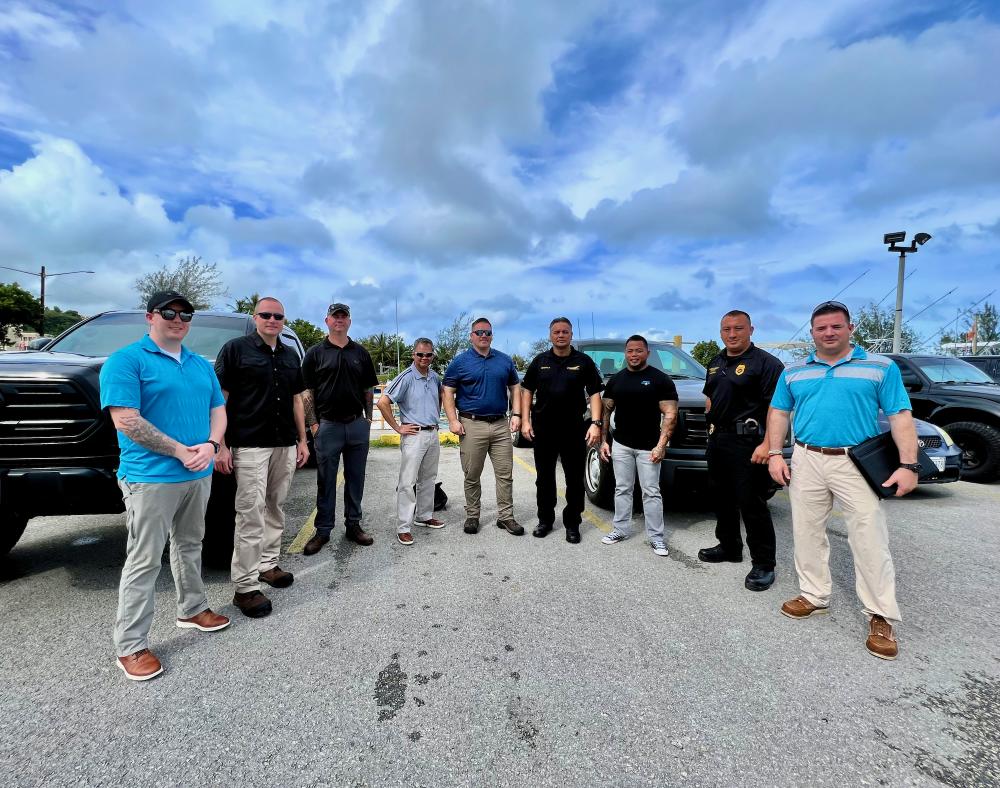Imagery Available: U.S. Coast Guard, Army National Guard conducting Port Security and Resiliency Assessments in Guam, CNMI
U.S. Coast Guard sent this bulletin at 12/08/2022 10:50 PM EST
| News Release |
U.S. Coast Guard Forces Micronesia / Sector Guam |
U.S. Coast Guard, Army National Guard conducting Port Security and Resiliency Assessments in Guam, CNMI



Editor's Note: Click on the images above to view more or download high-resolution versions.
SANTA RITA, Guam — The Port Security and Resiliency Assessment (PSRA) team is in Guam the week of Dec. 5, 2022, and will soon travel to Saipan to conduct comprehensive assessments of the commercial ports and other critical maritime infrastructure to provide insight into potential vulnerabilities and recommendations to mitigate any threats.
Capt. Nick Simmons, the Captain of the Port for Guam and the Commonwealth of the Northern Mariana Islands and commander of U.S. Coast Guard Forces Micronesia/Sector Guam, met with and welcomed the PSRA team Tuesday.
“There is no shortage of interest in building our regional resilience and capability out here, but it is a partnership, and we are committed to working closely with the Port Authority of Guam and our Department of Defense colleagues to do it right,” said Simmons. “We are excited to have the PSRA team here in Guam. The report they produce is designed to complement our Area Maritime Security Assessment and aids our federal maritime security coordinators. It is another tool we and our partners can use to be objective about port investments and support additional grants.”
The team consists of experts and technical specialists from the U.S. Coast Guard and the Army National Guard’s Critical Infrastructure Protection Battalion who apply their operations and emergency response backgrounds to these assessments. Their goal is to provide feedback on improving resiliency and mitigating threats from possible terrorism or natural disasters. This in-depth approach may not be regularly available to local port areas. In the past year, this team has been in Alaska and other parts of the contiguous United States.
“This is a no-fault non-regulatory assessment which provides an opportunity, not only to strengthen positive relations with port stakeholders, but also provide space for recommendations to enhance their security posture and support for improvements to existing infrastructure,” said Lt. Michael Bosch, team lead for CG-PSA-2.
Each assessment has four phases: (1) advance research and scoping, (2) pre-assessment, (3) assessment, and (4) post-assessment phase. The pre-and post-assessment phases are conducted at the home office in Washington, D.C. During the assessment, the team speaks with the on-site port and marina managers, does a walkaround, reviews procedures and physical security, and applies technology. This technology includes 3D imaging and drones to create a virtual tour, also called a panoramic tour, which is a wide-ranging view or video simulation of an existing place that is useful to many port users and managers.
In Guam, the team did a port ride along with U.S. Coast Guard Station Apra Harbor, met with port and Navy personnel, and assessed the commercial port, as well as Navy Base Guam, Agana Boat Basin also known as the Gregorio D. Perez Marina, and Agat Marina. They will soon go to the Commonwealth of the Northern Mariana Islands and assess Tanapag Harbor.
PSRAs can be used for several reasons, including to support an area maritime security assessment, typically through the assessment of five sites and one waterway based on top scenarios within the sector, scaled to focus on specific concerns within the port area, a national special security event, or video capture of a waterway to support training or maritime domain awareness needs. These assessments can also be used to support grant applications for port and waterway improvements.
As announced in October, the Jose D. Leon Guerrero Commercial Port, also known as the Port of Guam, is among several Western Pacific entities receiving federal grant money through the 2022 Port Security Grant Program to ensure supply chain resiliency within Guam and the Mariana Islands.
Guam and CNMI will receive close to $2.1 million from the PSGP, with the Port Authority awarded just over $564,000, Guam Customs and Quarantine awarded more than $526,000, and CNMI’s Commonwealth Port Authority receiving about $88,000. The PSGP is one of four grant programs under the Department of Homeland Security’s Federal Emergency Management Agency that focuses on strengthening the nation’s critical transportation security infrastructure.
The purpose of the PSGP is to provide the necessary funds for not only state partners but local, territorial, and private sector partners to enhance security measures and resilience to critical maritime infrastructure and build threat readiness.
For more U.S. Coast Guard Forces Micronesia/Sector Guam news, visit us on DVIDS or subscribe! You can also visit us on Facebook or Instagram at @USCGForcesMicronesia or Twitter @USCGFMSG.
-USCG-

